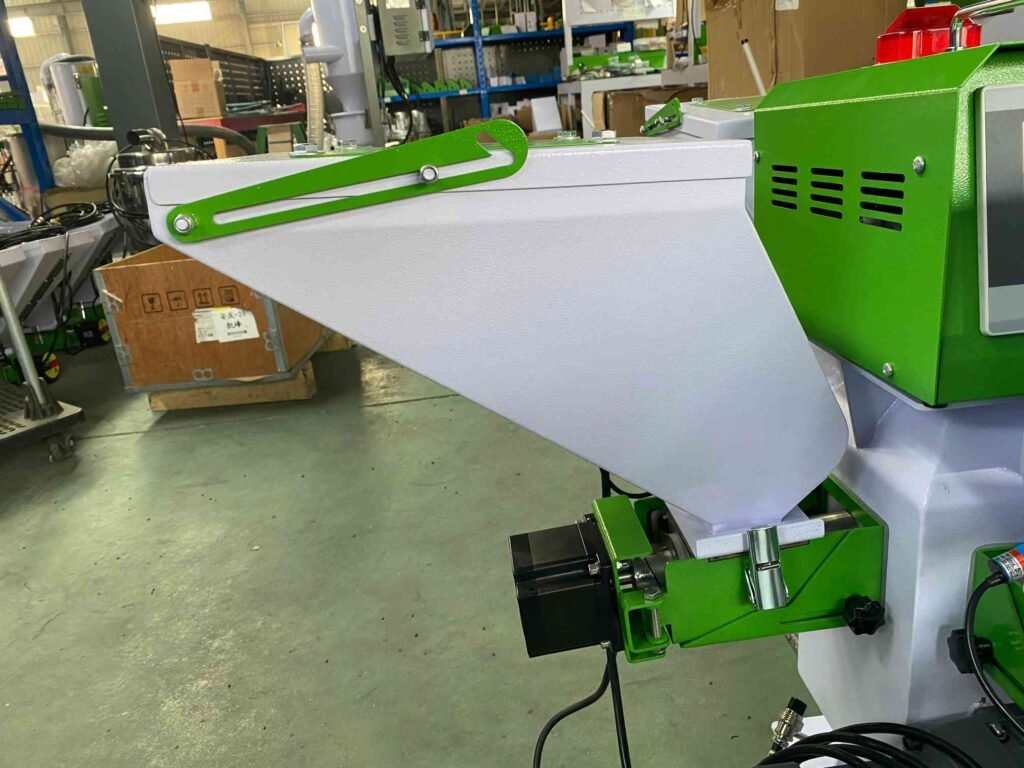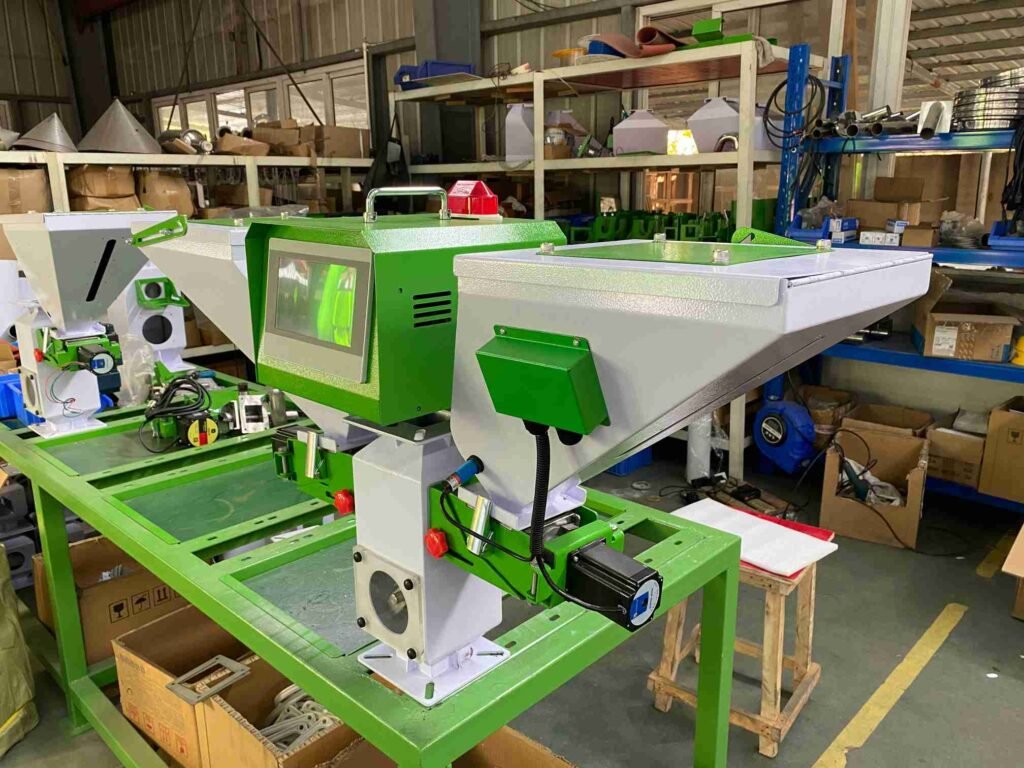En el campo de la transformación de plásticos, una dosificación precisa es un eslabón clave para determinar la calidad del producto y la eficiencia de la producción. Cuando las empresas se enfrentan a la elección de dosificadores volumétricos y los dosificadores gravimétricos, a menudo necesitan considerar múltiples dimensiones, como los principios técnicos, la rentabilidad y los escenarios de aplicación. En este artículo se analizan en profundidad las principales diferencias entre ambos sistemas y se ofrece una referencia profesional para la toma de decisiones.
Ⅰ. Principio de funcionamiento
1. Dosificadores volumétricos
Los dosificadores volumétricos utilizan la "ocupación de espacio" como base de medición y controlan la salida de volumen de los materiales mediante estructuras como tornillos y platos giratorios. Por ejemplo, un dosificador volumétrico de cuatro colores convierte los parámetros preestablecidos en velocidad a través de un sistema de control por microordenador totalmente digital para accionar un tornillo de precisión con el fin de extrudir materias primas con un valor de error no superior a ±1%. Este sistema debe calibrarse manualmente en función de la densidad del material. Cuando cambia el lote o el tipo de materias primas, es necesario reajustar los parámetros para garantizar la precisión de la medición.

2. Dosificadores gravimétricos
Los dosificadores gravimétricos se basan en células de carga para controlar el peso del material en tiempo real y utilizan la tecnología de "pérdida de peso" para lograr un control de bucle cerrado. El sistema seguirá midiendo hasta alcanzar el peso objetivo y no se verá afectado por las fluctuaciones de densidad del material. Al igual que una taza de 250 ml de nata líquida, el volumen se expande hasta 1000 ml después de batirla, pero su peso se mantiene siempre en 250 gramos; ésta es la principal ventaja de la medición por gravedad: la masa es el único parámetro y no es necesario realizar calibraciones frecuentes.
Ⅱ. Comparación de prestaciones: equilibrio entre precisión, coste y flexibilidad.
1. Precisión de medición
La precisión de mezcla de los dosificadores volumétricos suele ser de 95%-98%, lo que resulta adecuado para escenarios con requisitos de precisión medios (como la producción ordinaria de moldeo por inyección); los sistemas por gravedad se basan en el pesaje en tiempo real, con una precisión inferior a ±0,5%, lo que resulta más adecuado para plásticos modificados de gama alta o productos de grado médico.
2. Inversión de costes
La inversión inicial de los dosificadores volumétricos es baja. Por ejemplo, los dosificadores volumétricos de dos colores de Kaifeng Machinery adoptan un diseño modular, con una gran capacidad de intercambio de componentes, y los costes de mantenimiento pueden reducirse en más de 30%; el sistema de gravedad suele tener un coste de adquisición 30%-50% más elevado debido al sensor de pesaje integrado y al complejo sistema de control, pero a largo plazo puede conseguirse una optimización de los costes reduciendo el desperdicio de materias primas (ahorrando hasta 50% de aditivos).
3. Adaptabilidad de la producción
Los dosificadores volumétricos admiten el almacenamiento de 50 conjuntos de fórmulas y el cambio rápido, lo que resulta adecuado para la producción de lotes pequeños con múltiples variedades; el sistema por gravedad es más adecuado para la producción continua a gran escala, especialmente en escenarios en los que se requiere un registro estricto del consumo de material (como la certificación de calidad ISO).
Ⅲ. Guía de selección: El escenario adaptativo determina la solución óptima
1. Escenarios para dar prioridad a los dosificadores volumétricos
Si sus necesidades de producción se centran en la "rentabilidad", como los productos de plástico ordinarios, el procesamiento de reciclaje de materiales reciclados o el cambio frecuente de fórmulas (como el moldeo por inyección multicolor), los dosificadores volumétricos son una opción más pragmática. Por ejemplo, los dosificadores volumétricos de cuatro colores de Kaifeng Machinery utilizan piezas de contacto de acero inoxidable 304 y tornillos cromados, que no sólo garantizan la resistencia a la corrosión, sino que también permiten un rápido desmontaje y limpieza mediante un diseño modular, muy adecuado para pequeñas y medianas empresas.

2. Escenarios para dar prioridad a los dosificadores gravimétricos
Cuando los productos implican requisitos de alta precisión (como piezas aeroespaciales, catéteres médicos), o altos costes de materias primas (como nanoaditivos, pigmentos especiales), las características de "cero residuos" del sistema de gravedad son cruciales. Además, si el proceso de producción requiere una trazabilidad estricta del uso de materiales (como la industria de envasado de alimentos), los datos de pesaje en tiempo real del sistema de gravedad pueden conectarse directamente al sistema de gestión de calidad.
IV. Conclusión
Los dosificadores volumétricos y los gravimétricos no son relaciones competitivas del tipo "o esto o lo otro", sino soluciones complementarias para diferentes necesidades de producción. Para las empresas de transformación de plásticos, la comprensión de los límites técnicos y la lógica de costes de ambos permite encontrar un equilibrio entre eficacia y precisión. Al igual que las soluciones aportadas por fabricante de dosificadores volumétricos -- Kaifeng Machinery desde dosificadores volumétricos básicos hasta sistemas de gravedad de alta gama, siempre toman la "adaptación a los escenarios" como núcleo de diseño, ayudando a las empresas a conseguir mejoras de calidad a la vez que optimizan los costes de producción.
